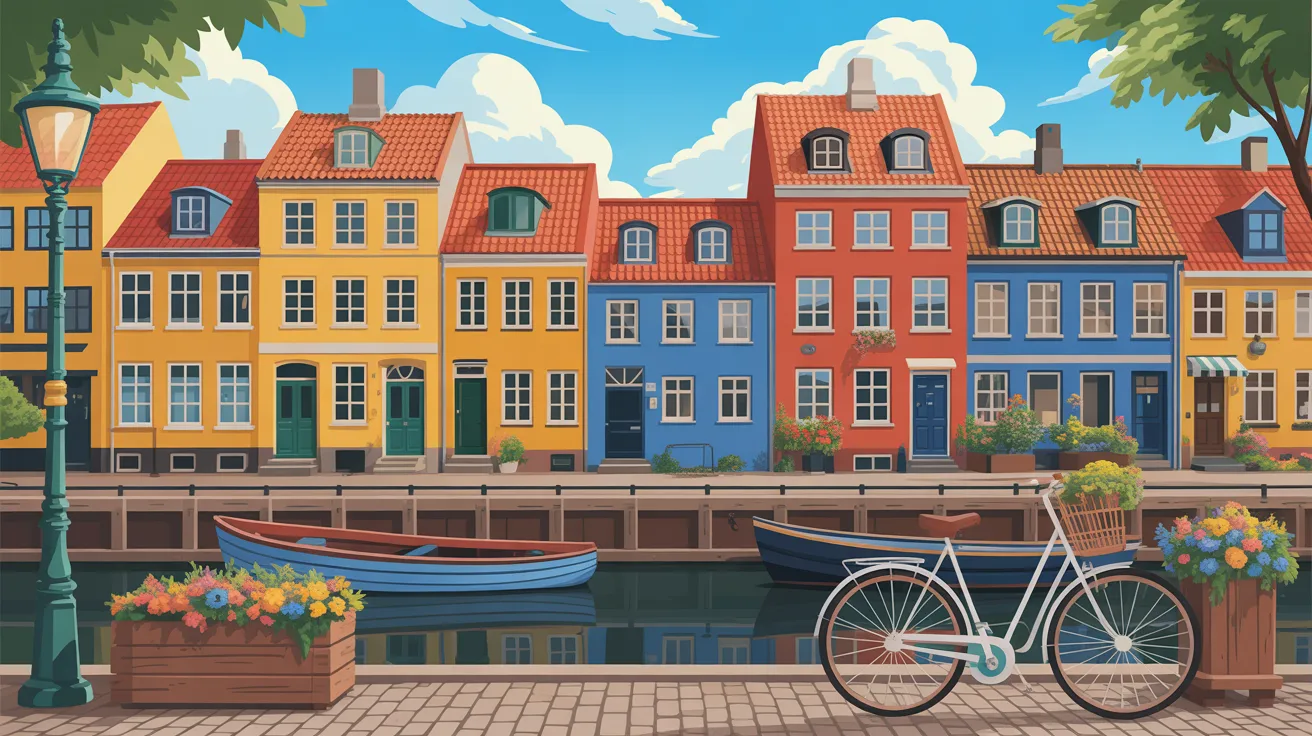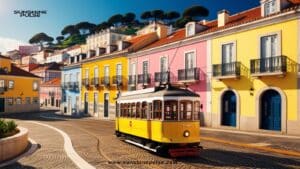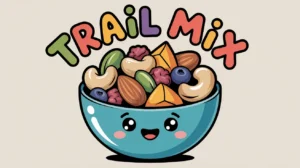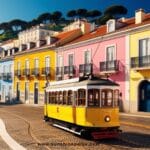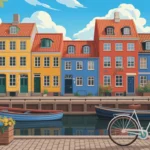There’s something wonderfully enchanting about Copenhagen Puns and Jokes—Denmark’s capital city that effortlessly blends fairy-tale charm with cutting-edge design, where bicycles outnumber cars, and where “hygge” isn’t just a word but a way of life. Founded as a Viking fishing village in the 10th century, Copenhagen (or “København” in Danish, meaning “merchant’s harbor”) has evolved into one of Europe’s most livable and happiest cities.
Interestingly, Copenhagen consistently ranks among the world’s happiest places, boasting colorful Nyhavn harbor houses, the iconic Little Mermaid statue, Tivoli Gardens (one of the world’s oldest amusement parks), and a cycling culture so strong that the city has more bikes than people! Additionally, it’s home to Nordic cuisine innovation, Viking history, and enough design aesthetics to make minimalists weep with joy.
But beyond the Instagram-worthy architecture and Danish pastries that could solve world conflicts, Copenhagen has also inspired a treasure trove of puns and jokes that are just as delightful as the city itself. So grab your bicycle, channel your inner Dane, and prepare to explore Copenhagen through the lens of laughter—no passport required!
🚴 Copenhagen Cycling Puns That Really Wheel You In
Pedal Power Paradise
Copenhagen is legendary for its cycling culture—with over 400 kilometers of designated bike lanes and approximately 62% of residents commuting by bicycle daily, it’s essentially a two-wheeled utopia. Moreover, cycling isn’t just transportation here; it’s a lifestyle, a statement, and occasionally a competitive sport among locals who gracefully navigate cobblestones while carrying groceries, children, and impressive amounts of dignity.
The city’s bike infrastructure is so advanced that it includes dedicated traffic lights for cyclists, bike superhighways connecting suburbs to the center, and parking facilities that rival car garages in organization. Furthermore, Copenhageners bike in all weather conditions—rain, snow, or shine—with a determination that impresses visitors and inspires numerous “I could never” comments from less hardy souls.
Therefore, cycling-themed Copenhagen humor celebrates this bicycle-obsessed culture while acknowledging that not everyone can master the art of biking stylishly in business attire through sleet without breaking a sweat (or their dignity).
Two-Wheeled Wit
- “Why don’t Copenhageners need gym memberships? Because they’re already Copenhagen their way to fitness!” Exercise disguised as transportation.
- “What do you call someone who doesn’t bike in Copenhagen? A tourist—or lost!” Identity markers through vehicle choice.
- “I tried to keep up with Copenhagen cyclists. They were Copenhagen away before I even started!” Speed differential acknowledgment.
- “Why did the bike fall in love with Copenhagen? It finally found a city that truly understood its needs!” Mechanical-municipal compatibility.
- “What’s a Copenhagen cyclist’s favorite music? Anything they can pedal to!” Rhythm-based transportation.
- “I asked for directions in Copenhagen. They said ‘bike three blocks.’ I said I was walking. They looked confused.” Alternative mobility incomprehension.
- “Why are Copenhagen bikes so happy? They’re always Copenhagen around town!” Perpetual motion satisfaction.
- “What did the car say in Copenhagen? ‘I’m feeling very outnumbered right now!'” Minority vehicle status anxiety.
- “The cycling infrastructure in Copenhagen is so good, bikes are basically Copenhagen their own civilization!” Parallel society development.
- “Why don’t Copenhagen cyclists get lost? They’re too busy Copenhagen forward to worry about direction!” Confidence through momentum.
- “What’s Copenhagen’s unofficial motto? ‘Keep calm and Copenhagen on!'” Modified British encouragement.
- “I rented a bike in Copenhagen. It came with a lock heavier than the bike. Priorities!” Security measures exceed equipment value.
🧜♀️ Little Mermaid and Fairy Tale Copenhagen Jokes
Where Stories Come to Life
Copenhagen holds a special place in literary history as the hometown of Hans Christian Andersen, whose fairy tales have enchanted generations worldwide. Additionally, the city honors this heritage with the famous Little Mermaid statue—perched on a rock at Langelinie promenade since 1913, she’s become Copenhagen’s most photographed resident despite being only 1.25 meters tall.
The statue’s history is as dramatic as any fairy tale: she’s been beheaded twice, lost an arm, been painted various colors by vandals, and even temporarily relocated. Moreover, tourists often express surprise at her modest size, expecting something grander for such an iconic symbol. Furthermore, Copenhagen embraces its fairy-tale identity with Tivoli Gardens’ storybook aesthetics, colorful architecture that looks plucked from illustrations, and an overall atmosphere that makes you half-expect trolls at every corner.
Therefore, Little Mermaid and fairy-tale humor plays on the contrast between magical expectations and pragmatic Danish reality, celebrating the city’s storybook charm while acknowledging its refreshingly down-to-earth character.
Once Upon a Pun
- “Why did the Little Mermaid stay in Copenhagen? She was too mer-maid for the city to let her go!” Pun-based residence permanence.
- “What’s the Little Mermaid’s favorite Copenhagen activity? Just sitting there judging tourists’ photo poses!” Passive-aggressive statue behavior.
- “I went to see the Little Mermaid. She was smaller than expected but Copenhagen expectations realistic!” Size-based reality adjustment.
- “Why is the Little Mermaid Copenhagen’s best employee? She never calls in sick or takes vacation days!” Ideal worker characteristics through bronze permanence.
- “What did Hans Christian Andersen think of Copenhagen? He found it to be a fairy tale Copenhagen true!” Author’s hometown appreciation.
- “The Little Mermaid has seen everything Copenhagen has to offer—mainly tourists taking selfies!” Limited perspective acknowledgment.
- “Why don’t fairy tales work in modern Copenhagen? Because everyone’s too hygge to have conflicts!” Danish comfort undermines narrative tension.
- “What’s Copenhagen’s most patient resident? The Little Mermaid—she’s been waiting for her prince since 1913!” Century-long romantic persistence.
- “I asked the Little Mermaid for directions. She just stared at me. Very unhelpful, Copenhagen say!” Communication limitations of statuary.
- “Why is Copenhagen perfect for fairy tales? Because the architecture looks Copenhagen from a storybook!” Visual consistency with literature.
- “What did the ugly duckling say about Copenhagen? ‘This city helped me Copenhagen into my true self!'” Transformation metaphor applied to location.
- “The Little Mermaid statue is small but mighty—much like Danish pastries, Copenhagen pack maximum impact!” Size-to-influence ratio.
Read more: 109+ Hot Air Balloon Jokes & Puns: You’ll Float Away!
🥐 Danish Pastry Puns That Are Flaky Good
Buttery Bliss Central
Copenhagen’s contribution to breakfast happiness cannot be overstated—Danish pastries, or “wienerbrød” (Viennese bread) as Danes actually call them, are ubiquitous throughout the city’s countless bakeries. Interestingly, despite being called “Danish” internationally, the pastry technique actually originated in Austria and was brought to Denmark by Viennese bakers during a labor dispute in the 1850s.
Moreover, Copenhagen’s bakery culture is serious business, with artisan bakeries competing for the title of best kanelsnegl (cinnamon roll) or perfect kringle. Additionally, the city has embraced New Nordic cuisine philosophy, elevating traditional pastries with innovative techniques and local ingredients while maintaining that essential buttery, flaky perfection.
Furthermore, Copenhageners have a special relationship with their pastries—they’re not just food but social glue, morning rituals, and edible expressions of hygge. Therefore, pastry-focused humor celebrates Denmark’s sweet contributions to world happiness while acknowledging that calories consumed in Copenhagen somehow feel less guilt-inducing when surrounded by such charm.
Crusty Comedy
- “Why are Copenhagen’s pastries so successful? They really know how to Copenhagen their dough together!” Business acumen through baking.
- “What do you call a Copenhagen bakery tour? A flaky but Copenhagen rewarding experience!” Textural description meets satisfaction.
- “I tried every pastry in Copenhagen. My waistline is now Copenhagen an existential crisis!” Physical consequences of culinary exploration.
- “Why don’t Copenhageners diet? Because life’s too short when you’re Copenhagen surrounded by pastries!” Philosophy trumps nutrition.
- “What’s Copenhagen’s secret to happiness? Butter, layers, and more butter—Copenhagen simple!” Reductionist wellness formula.
- “The pastries in Copenhagen are so good, they’re Copenhagen people back for generations!” Hereditary attraction to baked goods.
- “Why did the tourist gain weight in Copenhagen? Because ‘just one more’ Copenhagen into ‘just twelve more!'” Mathematical progression of consumption.
- “What do Copenhagen pastries and the city have in common? Both are Copenhagen perfectly layered!” Structural parallels between architecture and food.
- “I asked for a light breakfast in Copenhagen. They laughed and handed me a pastry Copenhagen with butter!” Dietary request misunderstanding.
- “Why are Copenhagen bakeries always crowded? Because everyone’s Copenhagen their morning ritual!” Communal tradition participation.
- “What’s a Copenhagen baker’s life motto? ‘Keep calm and Copenhagen baking!'” Occupational philosophy.
- “The pastries in Copenhagen are so fresh, they’re Copenhagen right out of the oven every five minutes!” Perpetual production cycle.
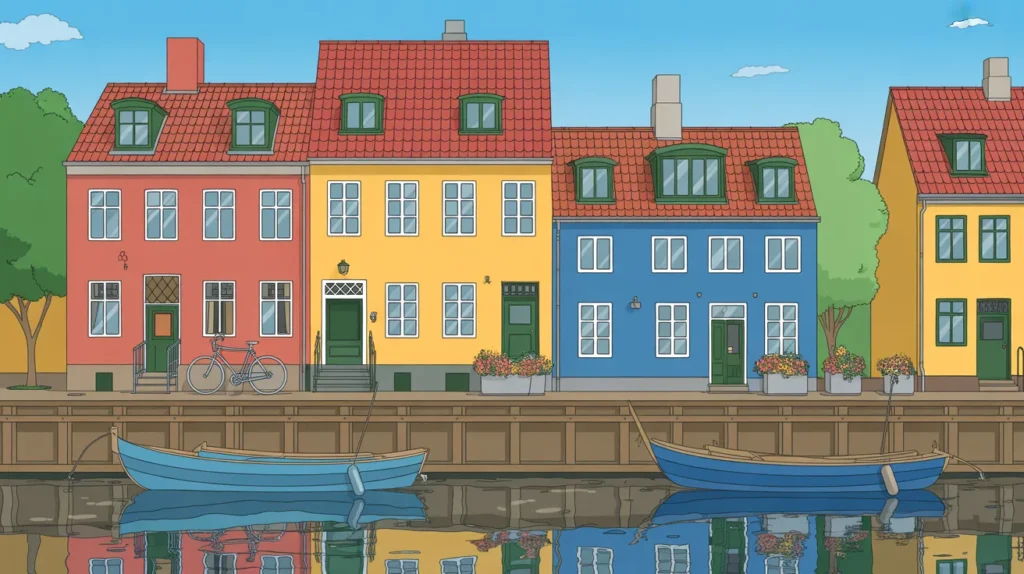
🏰 Historical Copenhagen Puns Worth Their Crown
Royal Humor from the Kingdom
Copenhagen’s history spans over a thousand years, from Viking settlements to becoming Denmark’s royal capital in the 15th century. Additionally, the city is dotted with historical treasures: Rosenborg Castle housing the crown jewels, Christiansborg Palace where Parliament meets, and the Round Tower—a 17th-century observatory with a unique spiral ramp instead of stairs (supposedly built so Peter the Great could ride his horse to the top).
Moreover, Copenhagen has weathered fires, bombings, occupations, and various disasters while maintaining its distinctive character. The city’s relationship with its monarchy remains strong—the royal family lives in Amalienborg Palace right in the city center, and Danish flags wave from buildings on special occasions with patriotic enthusiasm.
Furthermore, historical Copenhagen combined Viking heritage with Renaissance elegance, Baroque drama, and modern Scandinavian minimalism, creating architectural layers that tell centuries of stories. Therefore, history-themed humor celebrates Copenhagen’s past while acknowledging how seamlessly the ancient and contemporary coexist in this remarkable city.
Time-Tested Humor
- “Why do Copenhagen’s old buildings look so good? They’ve been Copenhagen care of for centuries!” Maintenance dedication results.
- “What did the Vikings think when founding Copenhagen? ‘This harbor is Copenhagen to be legendary!'” Predictive settlement wisdom.
- “I visited every historical site in Copenhagen. My feet are now part of the city’s history!” Physical integration through exhaustion.
- “Why is Copenhagen’s history so interesting? Because the city’s been Copenhagen it real since the Vikings!” Authenticity through longevity.
- “What’s the Round Tower’s favorite activity? Copenhagen circles around the same topic for 400 years!” Architectural shape humor.
- “The crown jewels in Copenhagen are stunning, but the real treasure is Copenhagen itself!” Value hierarchy recalibration.
- “Why did the Danish monarchy stay in Copenhagen? Because the city was Copenhagen too good to leave!” Royal retention reasoning.
- “What do Copenhagen’s castles and modern buildings have in common? Both are Copenhagen architectural excellence!” Cross-temporal quality consistency.
- “I tried to learn all of Copenhagen’s history. I’m still Copenhagen through the Viking era!” Educational timeline challenges.
- “Why are Copenhagen’s historical sites well-preserved? Because Danes are Copenhagen their heritage seriously!” Cultural preservation commitment.
- “What did the historical buildings say to modern Copenhagen? ‘We were Copenhagen it before it was cool!'” Hipster history claims.
- “The history of Copenhagen is fascinating—it’s been Copenhagen strong for over 1,000 years!” Resilience acknowledgment.
Related: 101+ Moving Jokes & Puns: You’re Gonna LOL!
🌈 Nyhavn and Colorful Copenhagen Jokes
Rainbow Harbor Reality
Nyhavn—Copenhagen’s iconic 17th-century waterfront—is perhaps the most photographed spot in Denmark, and for good reason. Additionally, this former red-light district turned upscale dining destination features vibrant townhouses in every color imaginable, creating a postcard-perfect scene that makes even phone cameras look professional.
Interestingly, Hans Christian Andersen lived at Nyhavn 20 for nearly two decades, presumably drawing inspiration from the harbor’s constant activity and colorful characters (both architectural and human). Moreover, the transformation from rough sailors’ quarter to tourist hotspot represents Copenhagen’s ability to honor history while embracing change—though locals joke that the only sailors there now are the ones on tourist boats.
Furthermore, Nyhavn embodies Copenhagen’s aesthetic philosophy: beauty doesn’t require conformity, color improves everything, and waterfront property should be accessible and enjoyable rather than exclusive and gated. Therefore, Nyhavn-themed humor celebrates the area’s Instagram-worthiness while gently mocking the tourist hordes (ourselves included) who can’t resist photographing the same view from seventeen different angles.
Harbor Hilarity
- “Why is Nyhavn so photogenic? Because it’s been Copenhagen its look since the 1600s!” Style longevity success.
- “What do you call a Copenhagen trip without Nyhavn photos? Incomplete—or Copenhagen wrong!” Essential experience validation.
- “I took 200 photos of Nyhavn. They’re all different! The clouds moved slightly!” Justification through minor variations.
- “Why are Nyhavn’s buildings so colorful? They’re Copenhagen their personality shine!” Architectural self-expression.
- “What’s a Copenhagener’s relationship with Nyhavn? ‘Beautiful but Copenhagen too touristy for me!'” Local appreciation with distance.
- “The restaurants at Nyhavn are expensive, but you’re Copenhagen paying for the view!” Location-based pricing justification.
- “Why did the artist love Nyhavn? The colors were Copenhagen inspiration flowing!” Creative stimulation through chromatics.
- “What do Nyhavn buildings and Copenhagen residents have in common? Both are Copenhagen standing proud!” Parallel characteristics celebration.
- “I tried to find an original angle for Nyhavn photos. Mission failed but Copenhagen trying!” Photographic innovation challenges.
- “Why is Nyhavn always crowded? Because everyone’s Copenhagen drawn to its charm!” Magnetic attraction explanation.
- “What’s the secret to Nyhavn’s success? Copenhagen the perfect combination of history and aesthetics!” Formula identification.
- “The tour guide said Nyhavn means ‘new harbor.’ It’s 400 years old. Copenhagen relative, I guess!” Temporal terminology questions.
☕ Hygge and Copenhagen Lifestyle Puns
The Art of Danish Coziness
Hygge (pronounced “hoo-ga”) is Denmark’s gift to vocabulary—that indefinable feeling of cozy contentment that encompasses everything from candlelit dinners to warm socks, from coffee with friends to reading under blankets during storms. Additionally, Copenhagen has essentially built its entire lifestyle around this concept, with cafés designed for lingering, homes lit with more candles per capita than anywhere else, and a social culture that prioritizes quality time over productivity.
Moreover, hygge isn’t just a aesthetic—it’s a survival strategy for getting through long, dark Nordic winters while maintaining sanity and happiness. Interestingly, Denmark consistently ranks among the world’s happiest countries despite having some of Europe’s highest taxes and gloomiest weather, suggesting that hygge might actually be medicinal.
Furthermore, Copenhagen’s approach to hygge has been commercialized and exported worldwide, inspiring countless books, Instagram accounts, and interior design trends. Therefore, hygge-themed humor gently mocks the concept’s trendy status while acknowledging its genuine appeal and the very real comfort it provides in Copenhagen’s cozy cafés and candlelit corners.
Cozy Comedy
- “Why are Copenhageners so happy? They’re Copenhagen hygge happening 24/7!” Lifestyle happiness correlation.
- “What’s the Copenhagen cure for sadness? Candles, coffee, and Copenhagen in a cozy corner!” Therapeutic formula revelation.
- “I tried to understand hygge intellectually. Wrong approach—you’re Copenhagen to feel it!” Experiential versus analytical understanding.
- “Why do Copenhagen cafés have so many candles? Because they’re Copenhagen the hygge vibe alive!” Atmospheric maintenance strategy.
- “What’s a Copenhagener’s winter survival kit? Blankets, hot drinks, and Copenhagen hygge mindset!” Seasonal equipment essentials.
- “The concept of hygge can’t be translated because it’s Copenhagen uniquely Danish!” Linguistic cultural specificity.
- “Why don’t Copenhageners rush? Because they’re Copenhagen busy being hygge!” Priority hierarchy clarification.
- “What’s Copenhagen’s approach to stress? Hygge it away until it’s Copenhagen manageable!” Therapeutic methodology.
- “I bought seventeen hygge books in Copenhagen. The irony of consuming capitalism while seeking simplicity is Copenhagen lost on me!” Self-awareness deficit.
- “Why are Copenhagen winters tolerable? Because everyone’s Copenhagen indoors being hygge together!” Communal coping mechanisms.
- “What’s the difference between cozy and hygge? About Copenhagen thousand candles!” Quantitative comfort distinctions.
- “The Copenhagen lifestyle is simple: bike everywhere, eat pastries, Copenhagen hygge. Living the dream!” Reductionist life philosophy.
Read more: 119+ Boot Jokes & Puns: You’ll “Kick” Yourself for Missing These!
🎨 Design and Architecture Copenhagen Puns
Where Form Meets Function Beautifully
Copenhagen is a design lover’s paradise, where Danish modernist principles have shaped everything from furniture to urban planning. Additionally, the city’s commitment to functional beauty—exemplified by designers like Arne Jacobsen and brands like Bang & Olufsen—has made “Danish design” synonymous with clean lines, natural materials, and objects that are as beautiful as they are practical.
Moreover, Copenhagen’s architecture ranges from medieval churches to contemporary masterpieces like the Black Diamond library extension and the Copenhagen Opera House. The city embraces bold modern additions while respecting historical context, creating urban landscapes where centuries coexist harmoniously.
Furthermore, Copenhagen’s design philosophy extends to everyday objects—from beautifully functional bicycle lights to minimalist café chairs that somehow remain comfortable. Therefore, design-focused humor celebrates Copenhagen’s aesthetic excellence while gently mocking the tendency to overthink a coffee cup’s philosophical implications or pay premium prices for deliberately simple objects.
Aesthetic Amusement
- “Why is Copenhagen so photogenic? Because every corner is Copenhagen designed for visual perfection!” Intentional beauty ubiquity.
- “What do you call Copenhagen’s design philosophy? Less is more, but Copenhagen paying more for less!” Minimalist pricing paradox.
- “I visited a design museum in Copenhagen. Left questioning whether my furniture has purpose. Copenhagen existential!” Object-induced philosophical crisis.
- “Why do Copenhagen chairs cost so much? Because they’re Copenhagen both art and seating!” Dual-function pricing justification.
- “What’s a Copenhagen designer’s motto? ‘If it’s not functional and beautiful, Copenhagen back to the drawing board!'” Quality standards enforcement.
- “The architecture in Copenhagen is stunning—old and new buildings are Copenhagen together perfectly!” Temporal harmony achievement.
- “Why don’t Copenhagen buildings clash? Because they’re all Copenhagen the same design language!” Aesthetic consistency maintenance.
- “What’s the difference between Copenhagen design and regular design? About Copenhagen hundred years of refinement!” Temporal excellence development.
- “I tried to adopt minimalist Copenhagen style. My wallet became minimalist too!” Unintended financial consequences.
- “Why is Copenhagen’s urban planning so good? Because they’ve been Copenhagen it right for decades!” Sustained excellence commitment.
- “What do Copenhagen designers and the city have in common? Both are Copenhagen timeless!” Parallel longevity qualities.
- “The design stores in Copenhagen are dangerous—everything’s Copenhagen tempting my credit card!” Financial vulnerability through aesthetics.
🎢 Tivoli Gardens and Entertainment Copenhagen Jokes
Where Nostalgia Meets Thrills
Tivoli Gardens, opened in 1843, isn’t just an amusement park—it’s a Copenhagen institution that has entertained generations while inspiring Walt Disney’s theme park vision. Additionally, Tivoli combines vintage charm with modern attractions, featuring ornate architecture, extensive gardens, concerts, and rides ranging from gentle carousels to stomach-dropping roller coasters.
Moreover, Tivoli operates seasonally with special themes for Halloween and Christmas, transforming the park into magical wonderlands that attract locals and tourists alike. Interestingly, the park maintains its historical character while continuously adding new attractions, proving that tradition and innovation can coexist Copenhagen-style.
Furthermore, Tivoli holds a special place in Copenhagen culture—it’s where first dates happen, childhood memories are made, and adults rediscover wonder through twinkling lights and the smell of æbleskiver (Danish pancake balls). Therefore, Tivoli-themed humor celebrates both the park’s nostalgic charm and the slightly surreal experience of riding roller coasters surrounded by 19th-century architecture in the middle of a modern capital.
Park Perfection Puns
- “Why has Tivoli survived since 1843? Because it’s been Copenhagen generations happy!” Multigenerational satisfaction longevity.
- “What do you call a Copenhagen visit without Tivoli? Copenhagen something crucial!” Essential experience identification.
- “I went to Tivoli expecting a simple amusement park. Got Copenhagen magical experience instead!” Expectation exceeding reality.
- “Why is Tivoli special? Because it’s Copenhagen history and fun in perfect harmony!” Successful combination achievement.
- “What’s Tivoli’s secret? Copenhagen the childlike wonder alive in everyone!” Universal appeal maintenance.
- “The rides at Tivoli range from gentle to terrifying, Copenhagen something for every courage level!” Inclusive fear accommodation.
- “Why do Copenhageners love Tivoli? Because it’s been Copenhagen part of their lives since childhood!” Nostalgic integration explanation.
- “What did Walt Disney think of Tivoli? ‘This is Copenhagen it right!'” Inspirational acknowledgment.
- “I rode every Tivoli ride. My stomach is now Copenhagen regrets, but my heart is full!” Physical-emotional trade-off assessment.
- “Why is Tivoli beautiful at night? Because they’re Copenhagen thousands of lights creating magic!” Illumination transformation effect.
- “What’s the best season at Tivoli? All of them—they’re Copenhagen seasonal magic year-round!” Perpetual excellence claim.
- “The food at Tivoli is expensive, but you’re Copenhagen paying for the experience!” Context-based value justification.
Related: 135+ Dumpling Puns & Jokes: You Won’t Be Able to Resist!
🌊 Copenhagen Harbor and Waterfront Humor
Maritime Marvel Jokes
Copenhagen’s identity is inseparable from its harbor—after all, the city’s name literally means “merchant’s harbor,” reflecting its historical role as a vital trading port. Additionally, modern Copenhagen has brilliantly reclaimed its waterfront for public use, creating harbor baths where brave (or crazy) locals swim year-round, waterfront promenades perfect for strolling, and the innovative “harbour buses” that function as floating public transport.
Moreover, the clean harbor water—the result of decades of environmental efforts—allows swimming right in the city center, a remarkable achievement that transforms urban waterfront from industrial space to recreational paradise. Interestingly, Copenhagen’s harbor swimming culture includes winter bathing enthusiasts who insist the freezing water is invigorating, a claim met with skepticism by less hardy souls.
Furthermore, the harbor connects Copenhagen to its maritime past while anchoring its sustainable future, with ferry connections to Sweden, innovative floating architecture, and a thriving waterfront culture. Therefore, harbor-themed humor celebrates Copenhagen’s unique relationship with water while acknowledging that not everyone shares the Danish enthusiasm for January ocean dips.
Waterfront Wit
- “Why do Copenhageners swim in the harbor? Because they’re Copenhagen cold water therapy seriously!” Extreme wellness commitment.
- “What’s the harbor’s best feature? Copenhagen clean enough to swim in—mind blown!” Environmental achievement recognition.
- “I tried winter harbor swimming in Copenhagen. Copenhagen say I survived, barely!” Survival-based accomplishment.
- “Why is Copenhagen’s harbor so beautiful? Because the city’s been Copenhagen care of it for decades!” Sustained maintenance results.
- “What do locals say about harbor swimming? ‘It’s refreshing!’ What they mean: ‘Copenhagen freezing!'” Euphemistic temperature description.
- “The harbor buses in Copenhagen are genius—Copenhagen public transport actually pleasant!” Innovation appreciation.
- “Why don’t Copenhageners fear the cold water? Because they’re Copenhagen Danish—cold is relative!” Cultural temperature tolerance.
- “What’s Copenhagen harbor’s transformation secret? Copenhagen environmental responsibility seriously!” Ecological commitment outcome.
- “I watched people harbor swim in December. Copenhagen braver than I’ll ever be!” Courage acknowledgment through observation.
- “Why is the harbor central to Copenhagen? Because the city’s been Copenhagen its maritime identity!” Historical continuity maintenance.
- “What’s the difference between Copenhagen harbor and other city waters? About Copenhagen hundred years of cleanup!” Environmental investment timeframe.
- “The harbor in Copenhagen is gorgeous—Copenhagen the perfect blend of history and modernity!” Temporal integration success.
🚲 Christiania and Alternative Copenhagen Puns
Free Town Humor
Christiania—Copenhagen’s autonomous “free town”—is perhaps the city’s most controversial and fascinating neighborhood. Established in 1971 when squatters occupied abandoned military barracks, Christiania operates as a self-governing community with its own rules, flag, and decidedly alternative vibe. Additionally, the neighborhood is famous for its colorful houses, creative atmosphere, artistic murals, and the contentious “Pusher Street” where cannabis is openly sold despite remaining illegal under Danish law.
Moreover, Christiania represents Copenhagen’s tolerance for alternative lifestyles and experimentation, though the relationship between the free town and Copenhagen authorities remains complicated. Interestingly, Christiania has become a significant tourist attraction, with visitors curious about this unique social experiment within a modern European capital.
Furthermore, the neighborhood’s ban on cars, emphasis on community, and distinctive aesthetic create an experience markedly different from the rest of polished Copenhagen. Therefore, Christiania-themed humor walks the line between celebrating alternative culture and acknowledging the neighborhood’s complexities—much like Copenhagen’s own approach to this fascinating anomaly within its borders.
Alternative Amusement
- “Why is Christiania unique? Because it’s Copenhagen its own rules inside Copenhagen!” Meta-jurisdictional humor.
- “What do you call Christiania? Copenhagen’s rebellious younger sibling!” Family dynamic metaphor.
- “I visited Christiania expecting chaos. Found Copenhagen organized alternative community instead!” Stereotype correction.
- “Why does Copenhagen tolerate Christiania? Because the city’s Copenhagen diversity seriously!” Ideological commitment demonstration.
- “What’s Christiania’s relationship with Copenhagen? Complicated but Copenhagen it work!” Functional dysfunction description.
- “The art in Christiania is incredible—Copenhagen creativity unleashed!” Aesthetic freedom results.
- “Why don’t cars enter Christiania? Because they’re Copenhagen the community car-free!” Intentional exclusion policy.
- “What makes Christiania controversial? Copenhagen pushing boundaries since 1971!” Persistent nonconformity.
- “I asked about Christiania’s future. Got Copenhagen different answers from everyone!” Opinion diversity acknowledgment.
- “Why is Christiania fascinating? Because it’s Copenhagen alternative social experiment live!” Ongoing sociological interest.
- “What do Copenhageners think of Christiania? Opinions are Copenhagen all over the spectrum!” Municipal perspective diversity.
- “The tour guide said ‘don’t photograph Pusher Street.’ Copenhagen respecting that rule!” Compliance through clarity.
🎊 Conclusion: Closing the Copenhagen Book (But Keep the Memories)!
Bringing It All Together
Well, there you have it—over 125 Copenhagen puns and jokes that hopefully brought as much joy as actually visiting this remarkable city! Whether you’re a Copenhagen veteran who’s biked every bike lane, a first-time visitor planning your itinerary, or an armchair traveler dreaming of Danish adventures, these puns celebrate everything that makes Copenhagen special—from its cycling culture to its hygge lifestyle, from fairy-tale charm to modern design excellence.
Copenhagen teaches us valuable lessons beyond just urban planning and pastry consumption. Moreover, it demonstrates that happiness comes from prioritizing quality of life over constant hustle, that cities can be both functional and beautiful, and that sometimes the best transportation is the simplest—just add bikes and infrastructure. Furthermore, Copenhagen proves that preserving history and embracing innovation aren’t contradictory but complementary, creating cities where past and future coexist in harmonious present.
Share the Danish Delight
These Copenhagen puns are perfect for breaking the ice with fellow travelers during your Nyhavn photo session, lightening the mood when rain cancels your cycling tour, or simply adding some Scandinavian humor to your group chat. Share them with your travel-loving friends, post your favorite alongside your Copenhagen photos, or save them for when someone needs convincing that Copenhagen deserves a spot on their bucket list.
Your Turn to Contribute!
So which Copenhagen pun made you smile the widest? Which one made you groan while simultaneously wanting to visit the city? Do you have your own Copenhagen jokes from personal travel experiences? Drop a comment below and share your favorites—we’d love to hear them!
And if these puns brightened your day like a Nyhavn sunset, share this article with fellow travelers, design enthusiasts, pastry lovers, and anyone who appreciates humor that’s Copenhagen good to resist! Now go forth, plan that Copenhagen trip (or just daydream about it while eating a Danish pastry), and remember: life is too short to not appreciate cities that prioritize bikes, beauty, and butter in equal measure. Stay hygge, friends! 🇩🇰✨
Read More: 115+ Softball Puns & Jokes: You’re Gonna Love These!
